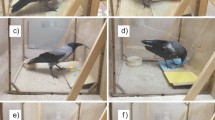Summary
A comparative study of seasonal food hoarding activity and tactile discriminatory ability in four species of heteromyid rodents (Dipodomys panamintinus, D. merriami, Perognathus longimembris, and P. formosus) was conducted in laboratory test arenas. Animals were tested individually to determine their treatment of seed (white millet) and seed mimics (glass beads and gravel) offered as food. In general, all animals showed low levels of millet hoarding activity during winter months with higher levels in fall and spring. Observations revealed that all species manipulated (with the forepaws) each potential food item prior to eating, pouching, or rejecting it. These tactile cues appear to surpass visual and olfactory cues as critical factors in distinguishing between food and food mimics. Pocket mice (Perognathus) showed high levels of tactile discriminatory ability which may serve as the mechanism by which they achieve high foraging efficiency in nature when “filter-feeding” for widely dispersed seed resources. Kangaroo rats (Dipodomys), on the other hand, are less adept at distinguishing between food and very similar non-food items. The fact that, in nature, kangaroo rats depend heavily on clumped food resources may obviate the need for highly efficient tactile discriminatory abilities.
Similar content being viewed by others
References
Brown JH (1973) Species diversity of seed-eating desert rodents in sand dune habitats. Ecology 54:775–787
Brown JH (1975) Geographical ecology of desert rodents. In: Cody ML and Diamond JM (eds), Ecology and Evolution of Communities. Belknap Press of Harvard Univ Press, Cambridge, Mass. p 545
Brown JH, Grover JJ, Davidson DW, Lieberman GA (1975) A preliminary study of seed predation in desert and montane habitats. Ecology 56:987–992
Brown JH, Lieberman GA (1973) Resource utilization and coexistence of seed-eating desert rodents in sand-dune habitats. Ecology 54:788–797
Brown JH, Reichman OJ, Davidson DW (1979) Granivory in desert ecosystems. Ann Rev Ecol Syst 10:201–227
French AR (1976) Selection of high temperatures for hibernation by the pocket mouse, Perognathus longimembris: Ecological advantages and energetic consequences. Ecology 57:185–191
French NR (1975) Activity patterns of a desert rodent. In: Prakash I and Ghosh PK (eds), Rodents in Desert Environments. W Junk, The Hague 225–239
French NR, Maza BG, Hill HO, Aschwanden AP, Kaaz HW (1974) A population study of irradiated desert rodents. Ecol Monogr 44:45–72
Hafner MS (1975) Species diversity and community interactions in Mojave Desert rodent communities. Unpubl. M.A. thesis, Occidental College, Los Angeles, CA, USA
Hawbecker AC (1940) The burrowing and feeding habits of Dipodomys venustus. J Mammal 21:389–396
Hutto RL (1978) A mechanism for resource allocation among sympatric heteromyid rodent species. Oecologia (Berl) 33:115–126
Kenagy GJ (1973) Daily and seasonal patterns of activity and energetics in a heteromyid rodent community. Ecology 54:1201–1219
Lemen CA (1978) Seed size selection in heteromyids. Oecologia (Berl) 35:13–19
Lemen CA, Rosenzweig ML (1978) Microhabitat selection in two species of heteromyid rodents. Oecologia (Berl) 33:127–135
Lockard RB, Lockard JS (1971) Seed preference and buried seed retrival of Dipodomys deserti. J Mammal 52:219–221
Price MV (1978a) The role of microhabitat in structuring desert rodent communities. Ecology 59:910–921
Price MV (1978b) Seed dispersion preferences of coexisting desert rodent species. J Mammal 59:624–626
Reichman OJ (1975) Relation of desert rodent diets to available resources. J Mammal 56:731–751
Reichman OJ (1976) Relationships between dimensions, weights, volumes and calories of some Sonoran Desert seeds. Southwest Nat 20:573–575
Reichman OJ, Oberstein D (1977) Selection of seed distribution types by Dipodomys merriami and Perognathus amplus. Ecology 58:636–643
Rosenzweig ML (1973) Habitat selection experiments with a pair of coexisting hetermyid rodent species. Ecology 54:111–117
Shaw WT (1934) The ability of the Giant Kangaroo Rat as a harvester and storer of seeds. J Mammal 15:275–286
Sokal RR, Rohlf FJ (1973) Introduction to Biostatistics. San Francisco: WH Freeman & Co
Smigel BW, Rosenzweig ML (1974) Experimental test for seed size selection and allocation in Dipodomys merriami and Perognathus penicillatus. Ecology 55:329–339
Tappe DT (1941) Natural history of the Tulare kangaroo rat. J Mammal 22:117–148
Trombulak SC, Kenagy GJ (1980) Effects of seed distribution and competitors on seed harvesting efficiency in heteromyid rodents. Oecologia (Berl) 44:342–346
Tucker VA (1962) Diurnal torpidity in the California pocket mouse. Science 136:380–381
Tucker VA (1966) Diurnal torpor and its relation to food consumption and weight change in the California pocket mouse, Perognathus californicus. Ecology 47:245–252
Wallace RJ (1978) Hoarding of inedible objects by albino rats. Behav Biol 23:409–414
Wondolleck JT (1978) Forage-area separation and overlap in heteromyid rodents. J Mammal 59:510–518
Author information
Authors and Affiliations
Rights and permissions
About this article
Cite this article
Lawhon, D.K., Hafner, M.S. Tactile discriminatory ability and foraging strategies in Kangaroo rats and pocket mice (Rodentia: Heteromyidae). Oecologia 50, 303–309 (1981). https://doi.org/10.1007/BF00344967
Received:
Issue Date:
DOI: https://doi.org/10.1007/BF00344967




